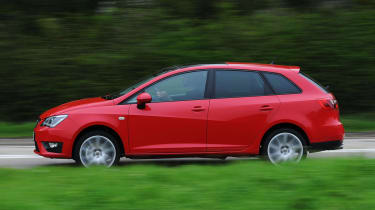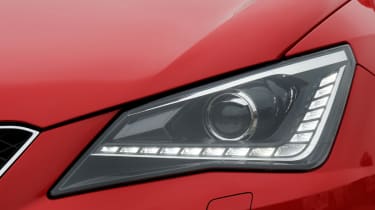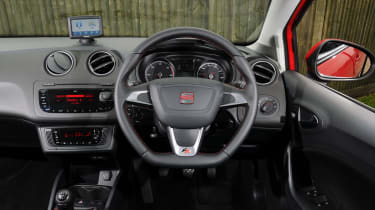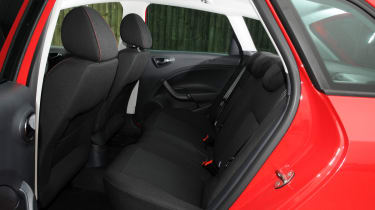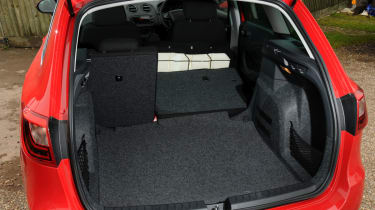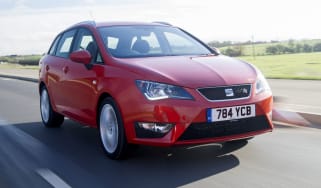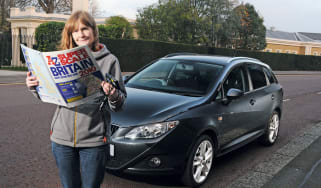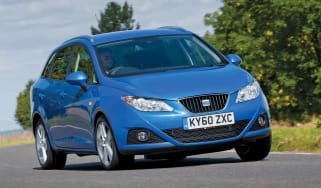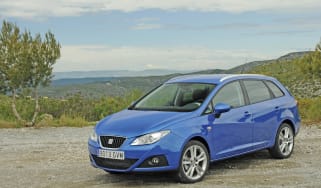SEAT Ibiza ST (2010-2017) review
SEAT’s stylish Ibiza ST looks smart, has a range of efficient engines and is a decent drive

The SEAT Ibiza ST is another model to fall by the wayside in this niche category: There are very few small estate superminis on the market in the UK now, and the Ibiza ST follows the Renault Clio Sports Tourer and Peugeot 208 SW by being replaced by a more stylish small crossover. With the arrival of the latest SEAT Ibiza hatch in 2017, the ST estate was dropped, and if you want a more practical model than the standard hatch, then the SEAT Arona is available instead.
It all means that those after something with a small footprint but lots of boot space aren’t spoilt for choice. The Skoda Fabia Estate is still going strong, or there are supermini-based MPVs like the Ford B-MAX and crossovers, but they aren’t quite the same thing.
Never afraid to buck a trend, the last SEAT Ibiza was one of very few cars in its class that was offered in three bodystyles: five-door hatch, three door ‘SC’ coupe and the estate here.
It was on sale for seven years, with a facelift in 2012 bringing a restyled front end and LED daytime running lights. In 2015, the exterior updates were even more subtle but new tech such as Apple CarPlay was brought in.
Used - available now

2022 Volkswagen
ID.3
16,600 milesAutomaticElectric
Cash £15,200
2021 SEAT
Arona
13,926 milesManualPetrol1.0L
Cash £13,800
2018 BMW
3 Series
27,300 milesAutomaticPetrol3.0L
Cash £23,487
2023 Peugeot
2008
48,844 milesManualPetrol1.2L
Cash £14,500Four trim levels were available on the 2015 facelift Ibizas: S, SE, Connect and FR. As of 2015, there were four petrol engines and one diesel, the latter with three different outputs.
A 1.0-litre three-cylinder non-turbo petrol with 74bhp kicks off the range, while the next engine is the 89bhp 1.2 TSI turbo. A new 94bhp ‘EcoTSI’ 1.0-litre turbo petrol is only available in SE spec, while there’s also a more powerful 1.2 TSI and a range-topping 148bhp 1.4-litre, with the latter only available in sporty FR spec.
The familiar 1.4 TDI diesel can be had in frugal 74bhp Ecomotive form, capable of 76.3mpg combined. Above that there are 89bhp and 104bhp versions with a bit more punch. Overall, it’s as wide an engine range as you’ll find in most hatchbacks, although unlike the larger SEAT Leon ST, there’s no Cupra variant of the Ibiza ST.
The SEAT Ibiza ST is still an attractive car and updates have kept it fresh. It’s now got the latest tech and engines, plus an improvement in interior quality, although its no match for the Skoda Fabia Estate for space or refinement. This is a small estate that’s more about the look than outright capacity.
Engines, performance and drive
The Ibiza is aimed at more youthful buyers than the Skoda Fabia, and it shows – not just in the look, but in the driving experience. It’s been set up to be sportier than its cousin, and you feel that on the road, which is both a good and bad thing.
The ST model gets no suspension changes over the 5-door Ibiza, but the longer body and weight over the rear does make a difference to the drive. Even so, body control is pretty good, with plenty of composure in the bends and direct, accurate steering. The driving position is excellent, too, helping with the driver enjoyment, but the diesel feels more nose-heavy than the lighter, more agile petrols.
Of course, the trade-off for the sporty feel on the road is a slightly firm ride. The Ibiza ST actually rides better than the hatchback thanks to the extra weight, but it’s still no Skoda Fabia for comfort. On S or SE models, the small wheels mean it’s never actually uncomfortable, although the bigger 16-inch alloys of FR spec means it can crash into potholes.
The Fabia is more refined, too. The petrol engines in the Ibiza are commendably quiet, especially the 1.0 and 1.4. It’s the diesel that’s the problem – as it is to a lesser extent in the Polo and Fabia. It makes a racket at idle and on the move, plus it isn’t as smooth as VW’s newer units. Road noise is more evident than in some equivalent cars but at least wind noise isn’t intrusive.
Engines
Like in the Ibiza hatch, there’s a variety of petrol engines on offer and a diesel with a broad spread of power outputs. The mixture of engines and specs is mind-boggling, however, as most engines can only be had in specific trims. For example, if you want the new EcoTSI 1.0-litre you can only have it in SE spec.
Base S-spec cars come with a non-turbo 1.0-litre three-cylinder producing just 74bhp. While the same engine feels peppy in the lighter Mii supermini, it struggles to shift the larger Ibiza so it feels a bit gutless out of town. It’s nippy at low speeds, though, so if you only drive about town it will be adequate.
Most buyers should try and step up to at least the 1.2 TSI turbo petrol, which can be had with 89bhp or 109bhp on the sporty FR model. With much more torque, it gives more flexibility at higher speeds and is smooth, although not a very characterful.
Our favourite is the new 1.0-litre EcoTSI. It’s incredibly refined, very efficient and punches well above its weight, feeling faster than its 0-62mph time of 10.8 seconds suggests. It also retains that fruity three-cylinder sound, but is only available on SE spec for some reason. It also can’t be had in higher-powered 109bhp format or with the DSG gearbox, unlike on the Ibiza hatch.
The top spec engine is the punchy and refined 148bhp 1.4 TSI, which, along with stiffer FR spec, makes the Ibiza ST a genuine warm estate. It also pushes the price uncomfortably close to larger estates, though, so it’s not for everyone.
The sole diesel engine, the three-cylinder 1.4 TDI, is very efficient in all of its three power outputs. It’s punchy and delivers its power in one big lump (especially in top-spec 104bhp form) but its only for high mileage drivers as it’s noisy and unrefined around town and under acceleration.
MPG, CO2 and Running Costs
Even though it’s not the newest kid on the block, the Ibiza ST’s economy figures aren’t too far behind the best in the class. Both the petrol and diesel engines are frugal, but the more modern Skoda Fabia Estate is even better.
The base 1.0-litre petrol engine suffers on the official combined cycle for its lack of a turbo, with a reasonable but not amazing combined figure of 53.3mpg and CO2 emissions of 120g/km. You’re likely to get close to that in the real world, however.
The turbo petrols are better in terms of combined cycle efficiency. The 1.2 TSI is more frugal, managing 57.6 mpg and emitting 116g/km in 89bhp form, and 54.3mpg and 119g/km in 109bhp form. But those after the best returns should look at the 1.0 EcoTSI: it manages a very impressive 67.3mpg combined and emits just 98g/km, so it’s a shame you’re restricted to SE trim and a five-speed manual gearbox.
The 1.4 TSI petrol offers a very good mix of performance and economy on paper: 0-62mph takes just 7.8 seconds, but it manages a claimed 58.9mpg on the combined cycle. Real-world economy will be more like 40mpg, however.
The diesels, as you’d expect, sip fuel. Even the most powerful model manages 70.6mpg combined, while the 74bhp Ecomotive claims 76.3mpg. The Fabia manages to match that latter figure with the most powerful diesel, however, so is the more efficient car on-paper.
Insurance groups
The Ibiza’s sister car, the Skoda Fabia, is extremely cheap to ensure thanks to its strong safety rating and reasonably-priced parts. The Ibiza isn’t quite as impressive, although it’s on a par with most rivals.
Whereas the Fabia Estate range starts in a lowly group 4E, the Ibiza ST with the same engine is in group 8E. That could be down to its sportier and more youthful image, and that the sharp bodywork is more expensive to repair after a crash.
Depreciation
The Ibiza ST isn’t a particularly common car, and small estates just aren’t as popular with UK buyers as they are on the continent. As a result, it’s expected to retain between 39 and 41 per cent of its value after three years, depending on trim and engine. The hatchback fairs fractionally better, while a VW Polo should retain quite a bit more.
Interior, design and technology
As you’d expect, the Ibiza ST looks identical to the hatch from the rear doors forward. Past the C-pillar, there’s an extra 175mm of length to incorporate the boot. Thankfully, the Ibiza’s age doesn’t show on the outside, as the sharp creases, wedgy front-end and sleek shape make it more appealing to look at than the rather bland Fabia. The rear bootlid is quite steeply raked which boosts the sporty looks but means compromises on practicality.
The 2015 facelift helped to improve materials significantly inside the Ibiza ST over the cheap-feeling previous versions, with more soft–touch material on the dash and a classier radio layout. There’s still some hard plastics on the doors and lower down the dash, but the Skoda Fabia has more. The instruments are clear and easy to read despite the sporty font.
Like on the hatch, SEAT is continuing its tradition of offering some vivid colour personalisation packs on the ST. Exterior colour coding can be added to the radiator grille and wing mirror housings, while you can also get two-tone alloy wheels. Inside, the air vent surrounds can be changed to several different colours, as can the stitching on the steering wheel and gear lever. Even so, the swathes of black plastic and rather dull dash layout are a missed opportunity, and don’t look as sporty as the outside.
Sat-nav, stereo and infotainment
SEAT has introduced a much fresher infotainment and navigation screen in the 2015 facelift. The basic Easy Connect system is a 6.5-inch touchscreen, which is clear and easy to use. It can, however, be further specced with sat-nav, DAB radio, and the ‘Full Link’ set-up which incorporates Apple CarPlay, Android Auto and MirrorLink smartphone connectivity. When it came out, the Ibiza was one of the cheapest cars on sale that offered this tech.
Practicality, comfort and boot space
Unfortunately, the sacrifice you make for the Ibiza’s good looks is evident when you step inside. The Ibiza is based on an older version of the VW Group’s small car platform than newer cars like the Fabia, and was designed from the start to be a sportier and less practicality-focused car. That means that, while the boot is now a reasonable size in the ST, the tight rear passenger accommodation remains unchanged.
Storage space isn’t that good either. The door pockets and glovebox are cramped, and other than a couple of cupholders under the dash there’s precious few practical touches.
The boot isn’t bad though: It’s well shaped and easy to access despite a high loading lip, and it’s considerably more versatile than the hatchbacks. It can also carry up to 515kg thanks to beefed up suspension. The Fabia Estate is noticeably bigger still, however.
Size
The SEAT Ibiza ST’s dimensions paint the picture of a spacious car. At 4,236mm, its 175mm longer than the hatchback, but all of that is behind the rear wheels. It’s no wider than the hatchback at 1,693mm – that makes it slightly narrower than most superminis in this class. It’s no taller than the hatchback either, at a maximum of 1,445mm, while it weighs around 50kg more.
Leg room, head room & passenger space
The hatchback isn’t known for being the most spacious supermini around, and the same is the case with the ST estate. While space up front is fine, very tall drivers will be more suited to the higher-roofed Fabia. The SEAT shows its older underpinnings in the back: Headroom is marginally better than the hatch thanks to the less sloping roof; the problem is legroom, which is tight for two average size adults and limits any ability to carry three rear passengers as the wheelbase is unchanged. It matters less in the hatchback, but it shows this car up as a “sports tourer” rather than a truly useable estate.
Boot
The boot is, obviously, the main reason why you’d choose the ST over the five-door. Whereas the regular Ibiza offers up 292-litres of space seats-up and 847 litres seats-down, the estate extends that to 1,164-litres with the seats folded down.
The process of doing that is a bit fiddly, though, and the bench doesn’t lie completely flat. Nevertheless, the space that’s left over is good, accepting that the similarly-priced Fabia Estate is both wider and more capacious: The capacity is 530-litres seats up and 1,370-litres seats down.
Reliability and Safety
Back in 2011 Euro NCAP awarded the Ibiza the maximum five-star rating for crash test safety. Standard fit front and side airbags plus stability control bolster this rating. However, the test has since been updated to include the assessment of active safety tech, so it might not do as well today.
Still, there is at least the option of kit such as active city braking and lane-keeping assist, and the facelift saw the introduction of a Tiredness Recognition System. This monitors the driver for signs that they are losing concentration. Multi-collision braking is also available which stops the car after an accident in case there’s a second impact.
One area for SEAT to improve in 2016 is owner satisfaction. The brand finished 15th out of 32 manufacturers in our 2015 Driver Power survey, which is a move in the right direction from its 24th place back in 2014. There’s still room for improvement given sister company Skoda came third in 2015 but then again, Volkswagen did slip down to 22nd place.
Reliability is another area the Spanish brand will be hoping to improve. It finished in a lacklustre 19th place, while its only car to finish in the top 100 was the Leon. The pre-facelift Ibiza finished in a poor 169th place, and given very little has changed mechanically we don’t expect that to improve any time soon. Teething problems of early cars should be sorted by now, though.
Warranty
SEAT’s standard three-year/60,000-mile factory warranty doesn’t look all that generous when compared with the seven-year/100,000-mile package offered on the Kia Rio or the five-year/unlimited mileage warranty that comes with the Hyundai i20. It’s fairly standard for most manufacturers, though. You can extend the Ibiza’s warranty to five years and 90,000 miles, but it will cost you.
Servicing
SEAT still insists on 10,000-mile service intervals for the Ibiza, although a fixed-price maintenance package is available. This provides two or three years of cover for a fixed monthly charge of £19.99.


